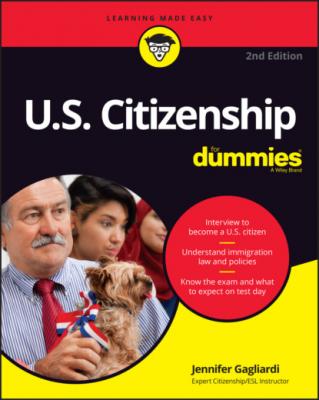ТОП просматриваемых книг сайта:
U.S. Citizenship For Dummies. Jennifer Gagliardi
Читать онлайн.Название U.S. Citizenship For Dummies
Год выпуска 0
isbn 9781119766896
Автор произведения Jennifer Gagliardi
Издательство John Wiley & Sons Limited
In order to immigrate through a family connection, your relative must file on your behalf with the USCIS an I-130 petition (www.uscis.gov/i-130) that includes proof of your familial relationship. This petition can now be filed online through a USCIS account (https://myaccount.uscis.gov/).
Assuming the USCIS approves the I-130 petition your relative filed for you, the State Department must determine if a visa number is immediately available. If you’re an immediate relative of a U.S. citizen, a visa will be available at once. If you fall within a family preference category, you will be placed on a waiting list (you can find more information on preference categories in the earlier section “Understanding the family preference categories”).
In order for your relative to be eligible to sponsor you to immigrate to the United States, they must meet the following criteria:
They must be a citizen or a lawful permanent resident of the United States and be able to provide documentation proving their citizenship or immigration status.
They must be at least 18 years old, in most cases, and at least 21 years old for U.S. citizen sons or daughters sponsoring a parent.
They must prove and document their relationship to you, the relative being sponsored.
Your relative must also document and prove that they can support you and any other financially dependent relatives at 125 percent above the mandated poverty line.
Your relative must prove they can support you by completing an Affidavit of Support (Form I-864) (www.uscis.gov/i-864) for you to file with the USCIS (if you’re adjusting your status) or with a U.S. consulate (if your visa is processing — there is a filing fee in this case). To complete an Affidavit of Support, your relative must live in the United States as their primary residence. The Affidavit of Support states that the sponsoring relative accepts legal responsibility for financially supporting you. Your relative must be able and willing to accept this legally enforceable responsibility until you go through the entire immigration and naturalization process and become a United States citizen or until you can be credited with 40 quarters of work (which usually takes about ten years).
Your relative must also complete an affidavit of support if they have filed an employment-based immigration petition (Form I-140; www.uscis.gov/i-140) as the employer on your behalf or if they have a significant ownership interest (5 percent or more) in a business that filed an employment-based immigrant petition for you.
In determining their income amount, your relative can include in the count
Money held in savings accounts, stocks, bonds, and property
Your income and, in some cases, your assets
The income and, in some cases, the assets of members of your relative’s household related by birth, marriage, or adoption or of those listed on your relative’s most recent federal income tax return (whether or not they reside with your relative)
Not surprisingly, meeting the financial support qualifications presents an insurmountable obstacle to many otherwise willing and qualified potential sponsors. In some cases, if the relative visa petitioner’s household income doesn’t quite reach the minimum 125 percent above the government-mandated poverty level, a joint sponsor may also be allowed to sign an additional affidavit of support. A joint sponsor is someone, other than the family member who is sponsoring you for immigration, who is willing to share legal responsibility, along with your family member, for supporting you if for any reason you are unable to support yourself after immigrating to the United States.
A joint sponsor must meet the same sponsorship qualifications as the sponsoring relative with one important exception: The joint sponsor does not need to be a relative of any kind (they can be, but that isn’t required in order for the person to qualify).
So how much is 125 percent above the mandated poverty level? The U.S. Department of Health and Human Services sets the annual poverty guidelines. For more information about financial support, visit the following resources:
USCIS document “How do I financially sponsor someone who wants to immigrate?” (www.uscis.gov/sites/default/files/document/guides/F3en.pdf)
USCIS I-864, Affidavit of Support Under Section 213A of the INA (www.uscis.gov/i-864)
USCIS I-864P, 2022 HHS Poverty Guidelines for Affidavit of Support (www.uscis.gov/i-864p)
HHS Poverty Guidelines (https://aspe.hhs.gov/topics/poverty-economic-mobility/poverty-guidelines)
Note the difference between the contiguous 48 states and U.S. territories compared to Alaska and Hawaii.
Identifying exceptions to the sponsorship requirements
As with all things related to U.S. immigration, there are exceptions to most rules, including the family member sponsorship requirements.
If you are the immigrant, and you can prove you’ve already legally worked in the United States a total of at least 40 qualifying quarters, as defined in Title II of the Social Security Act, an affidavit of support is not required. Because rules related to means-tested public assistance benefits changed in October 2021, see the following instructions for updates: USCIS Form I-864W Instructions for Request for Exemption for Intending Immigrant’s Affidavit of Support (www.uscis.gov/sites/default/files/document/forms/i-864winstr.pdf).
If the immigrant is the child of a citizen and if the immigrant, if admitted for permanent residence on or after February 27, 2001, would automatically acquire citizenship under the Immigration and Nationality Act, as amended by the Child Citizenship Act of 2000, they are exempt from sponsorship requirements. Approved in October 2000 by President Clinton, the Child Citizenship Act of 2000 states that a child born outside the United States automatically becomes a citizen of the U.S. when all the following conditions apply:

